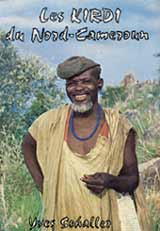Ethnographic Texts
Writings in French
The change in the production of French ethnographic texts from colonial officers to academic ethnographers coincides with the end of colonialism. Proper academic publishing begins with Podlewski’s demographic work in 1961. Ethnographic research is dominated by ORSTOM/CNRS geographers (Boutrais, Boulet, Hallaire, Seignobos, Iyebi-Mandjek), demographers (Gubry) and linguists (Barreteau, Tourneux, Colombel).
Pure ethnographic research is rare. The ORSTOM sociologist Martin publishes in 1970 a monograhic text on the Mafa. The CNRS anthropologist Vincent publishes on the Mofu-Diamare since 1971, culminating in two mongraphic volumes in 1991. Other important monograhic texts by anthropologist are the PdD thesis of Juillerat (1971) on the Muktele, Genest (1976) on the Mafa, and Richard (1977) on Mada and Muyeng.
Writings in German
Although Hinderling worked among the Mafa in the 1950s and 60s, he published a mongraph only in 1984. Graffenried’s PdD thesis on the Zulgo and Gemjek was published in 1984. Muller- Kosack’s MA and PhD thesis on the Mafa are from 1987 and 1997. The Habilitationsschrift of Godula Kosack (1998) deals with the social images of Mafa women.
ue to lack of knowledge of the German language, writings in German are ignored by ethnographers. In this context the two studies of the wider region need to be mentioned. It is Lukas’ or Wente-Lukas’ comparison of social and material cultures (1973, 1977), and Forkl’s historical comparison (1983, 1985). Wolff, a linguist, has published on the Lamang since 1971.
Writings in English
Professional ethnographic writing in English begins with Meek in 1931, followed by a long gap, until the beginning of the Mandara Archaeological Project in 1984. A result of the ethnohistorical research of the project are the PhDs of MacEachern and Gavua from 1990. The leader of the project is Prof. Nicholas David, who published extensively on the Northern Mandaras.
The latest PhD thesis is by Sterner’ on the Sukur (1998). Muller- Kosack produced an ethnographic survey on the Gwoza Hills in 1994 and started publishing his new material, especially on the Dughwede. Santen published her PdD on the process of islami- sation among Mafa women in 1993. Beek published many artic- les and a small book on the Kapsiki (1987).
Writings in Dutch
Dutch ethnograhic writing begins with van Beek’s PhD thesis on the Kapsiki in 1978. It is van Santen who follows him by working among the Mafa since the mid 1980s, and publishing articles on the Mafa from a feminist perspective. Schaaftsma (1998) and Roymans (1997) produced MAs about the Mafa. Although there is an increase in literature in Dutch during the 1990s, most of the researchers publish in English and French. Much of the Dutch research deals with the agricultural system and is geared towards development issues. Zuiderwijk’s PhD thesis from 1998 on the Mafa reflects this trend.
